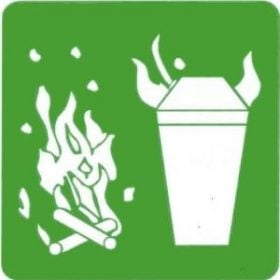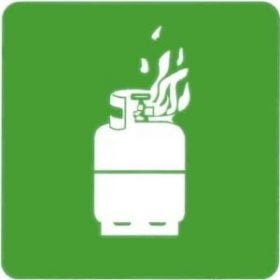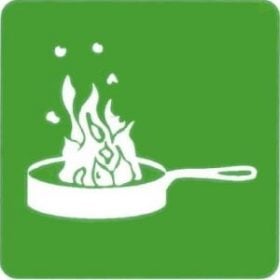Fire Protection Online
Saturday, November 30, 2019
All About Wet Chemical Fire Extinguishers
Tuesday, November 26, 2019
Car Fire Extinguisher
Car Fire Extinguisher – Don’t Leave Home Without It
Ways To Utilise A Car Fire Extinguisher
If you discover a fire inside the vehicle, you have to stop as quickly as possible. Do not try to put out the fire while the car is still running. After you stopped, get the extinguisher and pull the safety pin. Next, you have to intend the nozzle at the base of the fire, NOT in flames. You have to direct the extinguishing agent at the base since pointing it at the flames will just put out the fire momentarily. Squeeze the lever carefully and make a sweeping motion from side to side to extinguish the flames. Do this until you can be sure that the fire has gone out. Likewise, do not attempt to put out the fire if it is already big and dispersing. Leave the car instantly and call the fire brigade.Buying Car Fire Extinguisher
When buying a car fire extinguisher, you should first try to find a store that offers extinguishers certified according to New Zealand Standards. Extinguishers must meet NZS 4503:2005. Also, consider the size of the automobile when buying an extinguisher. Large cars, vans, and trucks, for instance, would be better off with a 2kg powder fire extinguisher.Small Fire Extinguisher Saving Car From Burning
From Our Blog Post https://fireprotectiononline.co.nz/car-fire-extinguisher/
Tuesday, November 12, 2019
What Are The Different Classes Of Fire?
Classes Of Fire
The fuel burning dictates the type of extinguisher you use to fight the fire. To help you understand this concept you need to know how fires are classified and which fire extinguishers are suitable for each class.Class A Fires
Class A fires start when materials such as paper, rubbish, wood, or other carbon-based materials ignite. Dry powder, foam and water extinguishers are suitable for this class of fire. Your best plan of attack would is to locate the nearest fire hose. This will give you a constant stream of water. The temperature at the base of the fire will cool to a point below that needed for combustion to take place.Class B Fires
Class B fires involve flammable liquids such as paints, oil, and petrol. With these materials, its the vapours of fumes that burn rather than the liquid. Because the vapours a lighter than air, they can drift away from the seat of the fire, and then ignite, causing what’s called a flash-off. This class of fire can be put out using carbon dioxide, dry powder ABE, or foam extinguishers. These starve the fire of the oxygen it requires for burning. Water will only help to spread the fire in this situation.Class C FIres
C Class fires are fires involving flammable gases, e.g. natural gas, hydrogen, propane, butane. Before fighting a Class C fire, you must turn off the gas if possible. ABE dry powder fire extinguishers are used to fight this class.Class D Fires
D Class fires are fires involving combustible metals such as sodium, magnesium, lithium and potassium. Specialised dry powders are available to control this class of fire. Sand also can smother the fire. Using water would produce hydrogen and cause an explosion.Class E Fires
Class E fires are electrical fires. They usually start because of a short circuit or arcing in loose connections or because wiring becomes overheated. You must be very careful here because there is the added risk of electrical shock as well as the threat from the fire. For all E Class fires, you should use either Carbon Dioxide extinguishers or Dry powder. Neither of these conducts electricity, and both starve the fire of oxygen. Never use water on Class E fires.Class F Fires
These are fires involving cooking fats and oils. The high temperature of these types of fats and oil when on fire far exceeds that of other flammable liquids. Wet Chemical extinguishers react with the surface of the oil or fat. This creates a soapy film barrier on the surface which seals off the air supply.Monday, November 4, 2019
How Often Do Fire Extinguishers Need To Be Inspected In NZ?
What Maintenance Does Fire Equipment Need?
It is through the use of firefighting equipment that people are able to save property and even lives when fire accidents occur. Schools, homes, and workplaces are safer with firefighting equipment installed in their compounds. Taking care of firefighting equipment is necessary. Inspection should be carried out regularly, either weekly, monthly or after every six months. The checks should ensure that the equipment is functioning correctly.
Failure to take proper care of your fire extinguishers will make the equipment less effective in case of a fire. As a result, a small fire accident that could have been dealt with quickly can become a catastrophe.
You should understand that there are two types of maintenance services that you should give your firefighting equipment, namely, professional and self-maintenance.
Professional Maintenance
As per NZS 4503:2005, It is a standard requirement in businesses for all fire equipment to undergo professional inspection once in a while. Professional maintenance has its advantages in that the experts can provide immediate solutions if a problem is identified, unlike self-maintenance, where you may not be able to provide required solutions in some cases.
In most cases, the company that installed the fire equipment is the one that carries out the inspection, but you can also hire a different company to do so. The following are some of the services that you should expect from a firefighting equipment technician:
Periodic Inspections

A professional fire equipment company will carry out inspection either six-monthly or annually. Some of the things that the technician will look at during the inspection include:
- Visual inspection of the external condition. Making sure there is no damage or corrosion.
- Cleaning. Making sure the signage and operation instructions are legible.
- Replacement of damaged components. This could include cracked hoses or damaged maintenance tags.
- Punch out the yellow maintenance tag to show inspection is current.
- Record-keeping of the work done during the inspection.
The company will also issue you with a certificate to show that your equipment has undergone inspection as required.
Internal Inspections
It is essential to understand that there are times when the extinguisher develops pressure issues from inside the tank. You will have to get a certified extinguisher technician, as you cannot do it on your own. The period after which this inspection is carried out varies depending on the device.
A professional fire equipment company will also look into the condition of the fire hose reels, smoke alarms, fire hydrants, and other automatic devices that help with firefighting.
Self-conducted maintenance

While it is vital to get professional maintenance services, carrying out your inspection is essential. With self-maintenance, you can also maximize the lifespan of your firefighting equipment. The following are some of the things that you should do when carrying out self-maintenance.
- Access your fire risks regularly- It is important to note different fire risks require different types of extinguishers. If you move into a new environment, ensure that the type of extinguisher that you have is suitable for the possible fire risks.
- Move the equipment to a location where they can be easily accessed in case of a fire accident. Any obstructions may make it difficult to access them hence more damages.
- Check for any corrosions on the tanks or pins which can block the nozzle
- You should also check to ensure that everything is in order, the pressure needle should be where it is expected to be, no cracks should be on the cylinder or nozzle.
from
https://fireprotectiononline.co.nz/how-often-do-fire-extinguishers-need-to-be-inspected-in-nz/
Friday, November 1, 2019
All About Water Fire Extinguishers
Water Fire Extinguishers
The water fire extinguisher is an excellent solution if you run the risk of Class A fires involving paper, rubbish, wood, cloth or other carbon-based materials. H2O is also one of the oldest extinguishants around that is still used to this day.It is common to pair up water with carbon dioxide extinguishers for indoor use. That covers your Class A, B and E type fires and doesn’t leave as much of a mess compared to dry powder.
How to Identify A Water Fire Extinguisher?
Water Fire Extinguishers are a full red cylinder with no band. They will also have the words water fire extinguisher printed on the front label. The cylinder is also made from stainless steel to prevent internal rusting.Where To Use A Water Fire Extinguisher
H2O extinguishers are suitable for use on class A fires such as:- Paper
- Wood
- Cloth
How Does A Water Fire Extinguisher Work?
Water reduces the temperature of the fire and propelled by nitrogen gas.When directed at flames, it lowers the general temperature, making it tough for the fire to burn and the flame to reignite.
If the water contains chemicals or has other impurities in it, the extinguisher may not operate as designed.
Water Extinguisher Sizes
9.0ltr – Water fire extinguisher.Advantages Of Water Extinguishers
Water is inexpensive and readily available.Zero impact on the environment.
It is an effective extinguishant on Class A fires.
Disadvantages Of Water Extinguishers
Water fire extinguishers are only suited for one Class of fire.Do not use on electrical fires due to shock hazards.
Using water fire extinguishers for fat and also flammable liquids will aggravate the fire.
How To Use A Water Fire Extinguisher
Like all other fire extinguishers, you need to remember the PASS-word.Pull the Pin
Aim at the base of the fire.
Squeeze the handle.
Sweep from side to side.
See our guide on How to Use a Fire Extinguisher.
From Our Blog Article All About Water Fire Extinguishers https://fireprotectiononline.co.nz/water-fire-extinguishers-nz/
Sunday, October 27, 2019
All About Foam Fire Extinguishers
Foam Fire Extinguishers
Foam fire extinguishers are an excellent solution if you run the risk of Class B fires involving flammable liquids, such as petrol and paint.Aqueous film forming foam (AFFF) is a synthetic foam concentrate consisting of fluorinated surfactants plus foam stabilisers which are mixed with water to form a foam.
The fluorine-free extinguisher is a next generation short chain based extinguisher with superior performance.
How to Identify A Foam Fire Extinguisher?
Foam Fire Extinguishers are a red cylinder with a blue band running all around the top. They also have a different nozzle compared to other extinguishers that are used to help mix the foam.Where To Use A Foam Fire Extinguisher
AFFF fire extinguishers are suitable for use on common flammable liquid fires such as:- Petrol
- Oil
- Paint
How Does A Foam Fire Extinguisher Work?
The Foam fire extinguisher works by providing a film on top of the fuel, starving the fire of oxygen.For class A fires not only does it remove the oxygen but also lowers the temperature thanks to the cooling effect from the water.
Foam Extinguisher Sizes
We stock two types of foam fire extinguisher9.0ltr – Foam AFFF fire extinguisher.
9.0ltr – Fluorine-free foam fire extinguisher.
Advantages Of Foam Extinguishers
Foam provides an extended lasting layer to control the fire after the extinguisher discharge is complete.It can also be used to form a vapour suppression barrier over flammable liquid spills.
Our new fluorine-free foam breaks down around 97% after 14 days. Thus making it an even more environmentally friendly option.
Disadvantages Of Foam Extinguishers
A foam fire extinguisher is mostly water. therefore should not be used on Class E fires.The aqueous solution is corrosive and requires to be cleaned after used, particularly on painted surfaces.
It is advised to not use foam extinguishers for class F fires.
How To Use A Foam Fire Extinguisher
Like all other fire extinguishers, you need to remember the PASS-word.Pull the Pin
Aim at the base of the fire.
Squeeze the handle.
Sweep from side to side.
From Our Fire Protection Blog Post All About Foam Fire Extinguishers
Tuesday, October 22, 2019
All About Carbon Dioxide Fire Extinguishers
Carbon Dioxide Fire Extinguishers
Carbon Dioxide extinguishers are the perfect choice for Class E fires involving electrical equipment. CO2 is a non-conductive & non-corrosive gas, because of this, it is the perfect solution for protecting computer & electrical equipment in the event of a fire. Carbon dioxide fire extinguishers can also be used on some Class B fires involving flammable liquids, such as petrol and paint.How to Identify A Carbon Dioxide Fire Extinguisher?
Carbon Dioxide Fire Extinguishers are a red cylinder with a black band running all around the top. They also have a different hose to other extinguishers ending with a horn.Where To Use A CO2 Fire Extinguisher
Due to the extinguishing agent not causing any damage to electrical equipment, it is the perfect extinguisher for areas such as- Electrical Switchrooms
- Server rooms
- Electrical appliance showrooms
- Offices
How Does A Carbon Dioxide Fire Extinguisher Work?
The CO2 Extinguisher contains carbon dioxide in a liquid form, and when the extinguisher used the liquid is released into the air, turning into a gas and offsetting the oxygen that the fire is feeding on. It also has a cooling effect, removing some of the heat.CO2 Extinguisher Sizes
The most common Carbon Dioxide Fire Extinguisher sizes found in New Zealand are- 2.0kg - Small size area to cover
- 3.5kg - Medium size area to cover
- 5.0kg - Large size area to cover
Advantages Of Carbon Dioxide Extinguishers
Being non-toxic and leaving no residue CO2 will not harm food, fabrics, machinery or electrical equipment. Carbon Dioxide is a non-conducting agent, so can be used on live electrical equipment. Holds its charge once used. However, you should have it recharged ASAP. Fairly cheap to have recharged.Disadvantages Of Carbon Dioxide Extinguishers
There is a risk of ice burn to your hands as the temperature of an extinguisher horn drops rapidly and freezes over. As CO2 works by displacing the oxygen around the fire, it is not suitable for outdoor use, or in environments exposed to windy conditions. CO2 is a high pressured extinguisher. Using it on class A fires or class F fires could cause the fire to spread. Users should use caution with how much CO2 is being discharged in small, confined areas.How To Use A Carbon Dioxide Fire Extinguisher
Like all other fire extinguishers, you need to remember the PASS-word. Pull the Pin Aim at the base of the fire. Squeeze the handle. Sweep from side to side.
From Our Fire Protection Blog Page https://fireprotectiononline.co.nz/carbon-dioxide-fire-extinguishers-nz/






